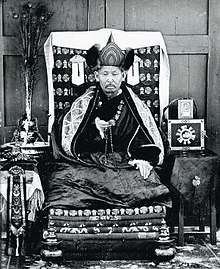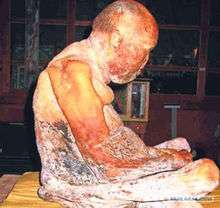Dashi-Dorzho Itigilov
Dashi-Dorzho Itigilov (Russian: Даши-Доржо Итигэлов; Buryat: Этигэлэй Дашадоржо, Etigelei Dashadorjo; 1852–1927) was a Buryat Buddhist lama of the Tibetan Buddhist tradition, best known for the lifelike state of his dead body, which is reported not to be subject to macroscopic decay.
Dashi Dorzho Itigilov | |
|---|---|
 | |
| Born | May 13, 1852 Ulzy Dobo (present-day Republic of Buryatia), Russian Empire |
| Died | June 15, 1927 (aged 75) |
| Citizenship | Soviet |
Biography
Itigilov was born in 1852 and began his religious education at the age of sixteen years. He studied at the Anninsky Datsan (a Buddhist teaching monastery in Buryatia, of which only ruins remain), earning diplomas in medicine and philosophy. At that time he wrote an encyclopedia of pharmacology.
In 1911, he was appointed the twelfth Pandido Khambo Lama (as the head of Russian Buryat Buddhists is styled), at which post he inaugurated the period of a Buddhist revival among Buryats. Between 1913 and 1917, Itigilov was prominent in the spiritual life of Imperial Russia. He took part in the Tercentenary celebrations of the House of Romanov and opened the Datsan Gunzechoinei, the first Buddhist temple in St. Petersburg. The tsar had him invested with the Order of St. Stanislas on March nineteenth, 1917.
During the First World War Itigilov presided over the society of "Buryat brothers", an organization helping the Russian army with money, provisions, clothes, and medicaments. He also helped set up a number of hospitals, with lama doctors helping wounded soldiers. For his charitable activities Itigilov was awarded the Order of St. Anna.
In 1926 Itigilov advised the Buddhist monks to leave Russia, since "the red teaching was coming to land", himself choosing to remain in the country. A year later, aged seventy-five years, he asked other lamas to begin meditation ceremonies and funeral rites, since he said he was about to die. Lamas did not want to perform this meditation because Itigilov was still alive. As a result, Itigilov began to meditate alone until other lamas joined him and he soon ceased to breathe.
After death
Itigilov left a testament asking to be buried as he was at the time of his death, sitting in lotus posture. According to his wishes, his body was put into a pine box and interred at a bumkhan (a graveyard for the lama burials) in the locality of Khukhe-Zurkhen (Dark-blue Heart in Buryat language). One of the testament clauses stipulated that his body should be exhumed by other monks within several years.

In 1955 and in 1973, Itigilov's body was examined by Buddhist monks, who were astonished to observe no signs of decay. They were too reluctant to divulge their finding to the anti-religious authorities of the Soviet Union and the body remained in situ until 2002.
On September 11, 2002, Itigilov's body was eventually exhumed in the presence of the leaders of the Buddhist Traditional Sangha of Russia. The body was transferred to Ivolginsky datsan (a residence of today’s Hambo Lama) where it was closely examined by monks as well as by scientists and pathologists. The official statement was issued about the body – it was "in the condition of someone who had died 36 hours ago", very well preserved, without any signs of decay, with whole muscles and inner tissue, soft joints and skin.[1]
A report by Al Jazeera states that the body had been preserved by being packed in salt and shows recent footage of the body being removed from this salt, although the reporter was not clear about when the salt was first applied.
The Buddhist monks approach him as a living person and shake hands with him. Some devotees even claim that Itigilov is still alive, only immersed in a hibernation- or nirvana-like state.
On April 23, 2003, the Buddhist conference recognized the body of Dashi-Dorzho Itigilov as one of the sacred Buddhist objects of Russia. At that time, they laid the foundation stone for a temple entitled Itigel Khambyn ordon and consecrated to Dashi-Dorzho Itigilov. As of 2005, Itigilov's body was kept out of doors, in contact with other people, without preserving any temperature or humidity regimens.
In April 2013, Vladimir Putin went to Buryatia to "hold a conversation" with Itigilov and other lamas.[2]
See also
References
- Buddhist Channel | Buddhism News, Headlines | Europe | Pilgrims Flock to Buddhist Center to See Their Lama at www.buddhistchannel.tv
- "Разговор по-дацански". 4 December 2013. p. 3. Retrieved 20 October 2017 – via Kommersant.
External links and references
- Hambo Lama Itigilov at the Buddhist Channel
- Video report about the case on YouTube
- (in Russian)Itigilov at the site of the Ivolginsky datsan
- A Russian Lama's Body, and His Faith, Defy Time from the New York Times